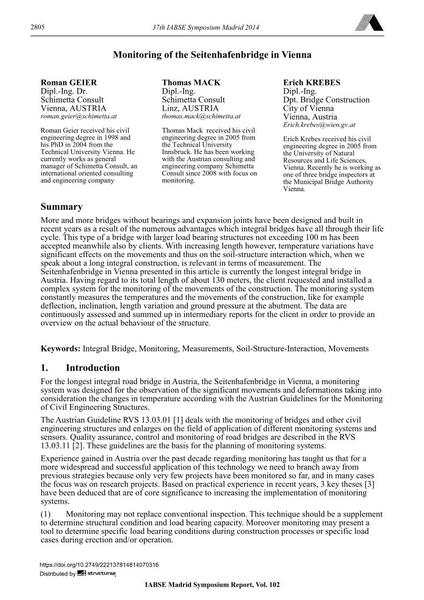Monitoring of the Seitenhafenbridge in Vienna

|
|
|||||||||||
Bibliographic Details
| Author(s): |
Roman Geier
Thomas Mack Erich Krebes |
||||
|---|---|---|---|---|---|
| Medium: | conference paper | ||||
| Language(s): | English | ||||
| Conference: | IABSE Symposium: Engineering for Progress, Nature and People, Madrid, Spain, 3-5 September 2014 | ||||
| Published in: | IABSE Symposium Madrid 2014 | ||||
|
|||||
| Page(s): | 2805-2812 | ||||
| Total no. of pages: | 8 | ||||
| Year: | 2014 | ||||
| DOI: | 10.2749/222137814814070316 | ||||
| Abstract: |
More and more bridges without bearings and expansion joints have been designed and built in recent years as a result of the numerous advantages which integral bridges have all through their life cycle. This type of a bridge with larger load bearing structures not exceeding 100 m has been accepted meanwhile also by clients. With increasing length however, temperature variations have significant effects on the movements and thus on the soil-structure interaction which, when we speak about a long integral construction, is relevant in terms of measurement. The Seitenhafenbridge in Vienna presented in this article is currently the longest integral bridge in Austria. Having regard to ist total length of about 130 meters, the client requested and installed a complex system for the monitoring of the movements of the construction. The monitoring system constantly measures the temperatures and the movements of the construction, like for example deflection, inclination, length variation and ground pressure at the abutment. The data are continuously assessed and summed up in intermediary reports for the client in order to provide an overview on the actual behaviour of the structure. |
||||
| Keywords: |
integral bridge movements monitoring measurements Soil-Structure-Interaction
|
||||

